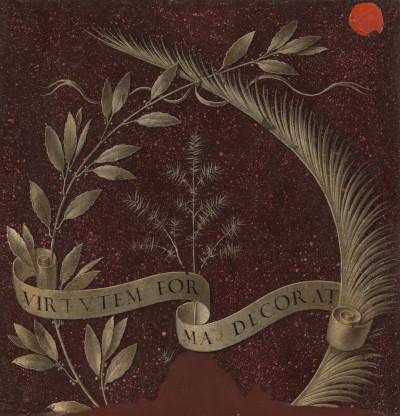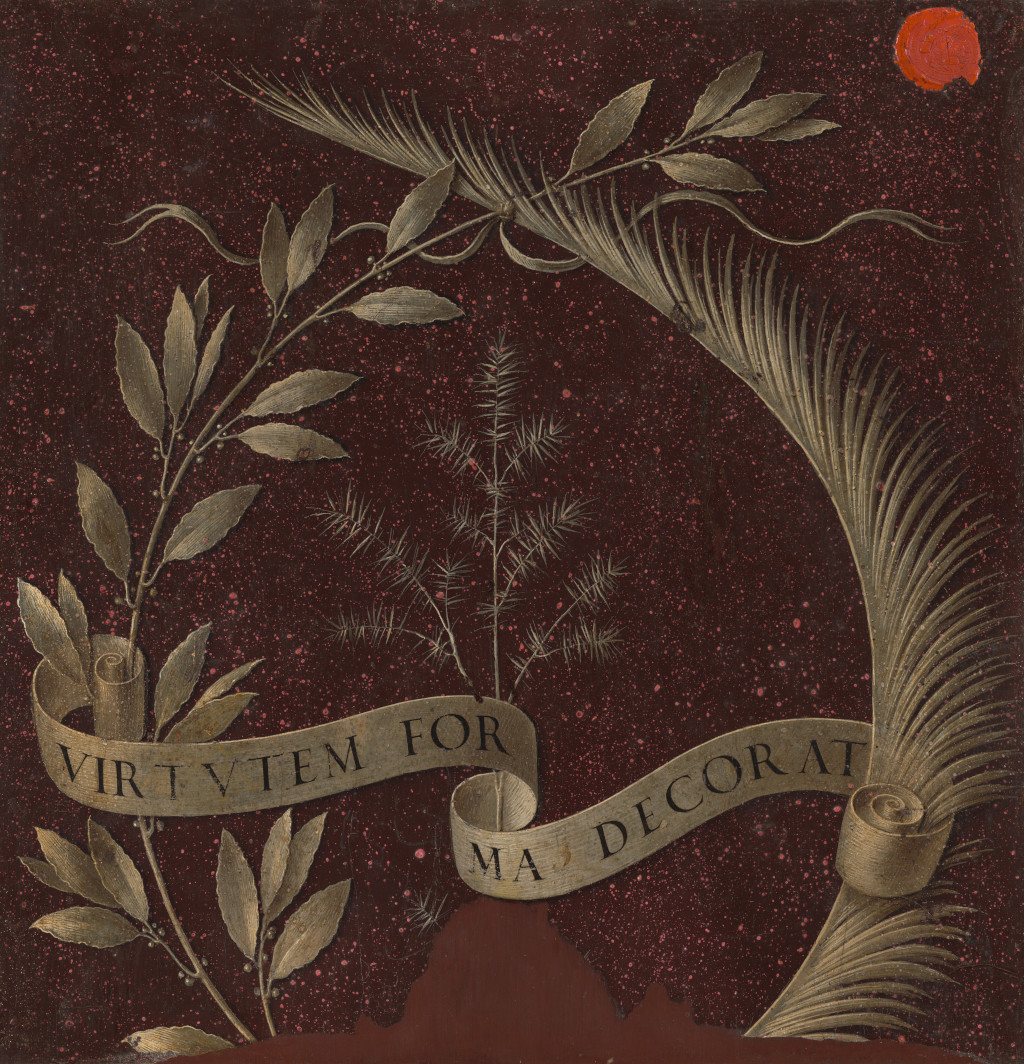On the reverse of Leonardo da Vinci's Portrait of Ginevra de' Benci from circa 1474–1478, you can find this painting titled as Wreath of Laurel, Palm, and Juniper with a Scroll inscribed Virtutem Forum Decorat.
Introduction
Scientific research from the 20th century has allowed art historians to discover all manner of hidden artworks from the Renaissance. Some would be preparatory sketches which were later amended, whilst sometimes entire paintings have been scrapped and worked over by entirely different compositions. In this case, the reverse painting was preserved perfectly, but many were unaware of it because it would be hidden to the viewer. Experts in the career of Leonardo have evaluated every aspect of his career, delving into reverse pieces such as this, as well as his individual drawings, unfinished paintings and even his diary entries.
Frank Zöllner mentions how there remains some questionmarks over the attribution of this reverse painting. Some have claimed that it was completed by a right handed artist, which would rule out Leonardo. It may have been that he amended the original work, before then working on the main side entirely by himself. Some have suggested that the styling of Wreath of Laurel, Palm, and Juniper with a Scroll is more in line with a Venetian artist, but many other theories have also been put forward. This side of the painting has always remained in the shadows, literally, and so much less research has been afforded to it than to the portrait of Ginevra de' Benci.
The portrait itself marked an important point in Da Vinci's career in which he moved away from religious art for a short period and focused on secular portraiture which brought a new sphere of work into his oeuvre. It resulted from a new type of patron becoming available to him, namely private individuals who required portraits of loved ones using the finest artist that they could find. He would produce several of these before then returning to religious themes later on, as well as expanding into other disciplines such as literature, mathematics, science and invention.
In this article we provide all detail currently available on this lesser known reverse painting, as well as the location in which the two-sided painting can be found. We examine the artwork itself, and provide meaning to the different elements found within it. We also discuss the size and medium of the piece, with Da Vinci having worked in oils for the portrait, but only tempera for this unusual depiction of a Wreath of Laurel, Palm, and Juniper with a Scroll. We also examine the meaning behind the text found on the scroll, and how this and the painting on the front are connected.
Table of Contents
Description
The artwork features a small sprig of juniper, placed centrally. There is then a wreath of laurel and palm, with lettering written horizontally across a scroll. Virtvtem Forma Decorat has been translated as meaning "Beauty adorns virtue" and many theories have been put forward as to its meaning. The background is entirely darkened, other than some small dots of colour. Whilst this painting is fairly simple, each element is executed beautifully, suggesting that whoever was responsible for putting it together was clearly highly skilled and experienced. You may notice that a small section of the bottom is missing detail, and part of this could have been cropped due to damage, probably occurring in the years that passed after Da Vinci's death.
Meaning
Most of the items within this painting hold symbolic meaning, or so scholars believe. The laurel and palm are known to be the personal emblem of Bernardo Bembo, who had a relationship with Ginevra de Benci, who is pictured on the other side of this painting. Many have concluded, therefore, that it was he who commissioned the artwork, and that this reverse artwork was related to his relationship with his friend. Additionally, the Italian word for juniper is similar to Ginevra, meaning that the sprig placed centrally within this composition is related to the beautiful woman on the other side of this two-sided piece.
Location
Leonardo da Vinci's portrait of Ginevra de' Benci, along with this design of a Wreath of Laurel, Palm, and Juniper with a Scroll which is found on the reverse, can be found today at the National Gallery of Art, Washington, D.C., USA. Typically the artwork will be hung on the wall in a manner which hides the reverse side from the public, with most people much more interest in this famous portrait. It is only those who look more deeply into the artist's career that discover this lesser known reverse painting, though it is still worthy of note, particularly when considering that only around 25 paintings are confidently attributed to Leonardo from his entire career.
Provenance
Portrait of Ginevra de' Benci, including this reverse painting on the back, was acquired by the National Gallery of Art in Washington D.C., USA in 1967, using help from the Ailsa Mellon Bruce Fund. It had earlier been purchased by Prince Johann Adam Andreas I von Liechtenstein in the 16th century but its provenance up to that point is something of a mystery. It would remain in the region of Austria and Liechtenstein until then passing across to the US in the 20th century, becoming the only Da Vinci painting permanently displayed in the country.
Size and Medium
As the reverse of the portrait of Ginevra de Benci, both artworks are naturally the same size, at 38.1 x 37 cm (15 x 14 9/16 in.). Most of Leonardo's secular portraits were of a similar, relatively small, size. He liked to use small panels of wood for single portraits, but would then glue or nail panels together when greater detail was to be used, such as with complex religious scenes. This reverse artwork was produced using tempera, where as the full portrait on the front was in oils. He would combine the two together in the early part of his career, but over time would transition to using only oils in the latter part of his career.
Large Image of Wreath of Laurel, Palm, and Juniper with a Scroll
See below for a larger image of the reverse artwork. Few people will be able to view this piece, as even the original is hidden on display, with the portrait of Ginevra de Benci shown to the public instead. Despite this reverse paintings of a Wreath of Laurel, Palm, and Juniper with a Scroll being something of an after thought, the detail was still beautifully crafted and much better represented by the larger, higher resolution image found below. Even the original text written on the scroll can be found here.
References
- Leonardo. The Complete Paintings and Drawings, Frank Zöllner & Johannes Nathan, Taschen
- Leonardo da Vinci, Walter Isaacson





